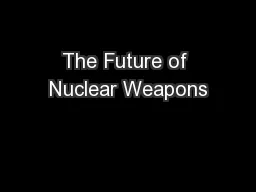

More proliferation or further reductions Keith Hansen February 19 2015 Introduction Cover central issues regarding nuclear weapons Uncertainty of US Russian relations amp China raises doubts about further reducing our nuclear arsenal ID: 374194
Download Presentation The PPT/PDF document "The Future of Nuclear Weapons" is the property of its rightful owner. Permission is granted to download and print the materials on this web site for personal, non-commercial use only, and to display it on your personal computer provided you do not modify the materials and that you retain all copyright notices contained in the materials. By downloading content from our website, you accept the terms of this agreement.
Slide1
The Future of Nuclear Weapons
More proliferation or
further reductions
?
Keith Hansen
February 19,
2015Slide2
Introduction
Cover central issues regarding nuclear weapons
Uncertainty of US – Russian relations & China raises doubts about further reducing our nuclear arsenal
Potential proliferation and ISIS/ISIL activities raise questions about the utility of nuclear weaponsSlide3
Key
Questions
Which
countries have nuclear weapons?
Why
do other countries want nuclear weapons?
Should
we be concerned about further proliferation?
Are
nuclear weapons really useful?
Is
the total elimination of nuclear weapons likely?
Are
terrorists likely to use nuclear weapons?Slide4
Terminology
& Concepts
Weapon-grade
fissile material (U-235 &
Plutonium
)
Nuclear
bombs & warheads
Nuclear
weapon systems Slide5
US
& Russian strategic nuclear arsenals
Cold War:
From
a few bombs (
late 1940s
) to over 10,000 deployed
bombs
& warheads (
1980s
)
Post-Cold War
:
START (1991) – reduced bombs/warheads to 6,000
SORT
(2002) – further reduced to ~3,500
New
START (2010) – now reducing to ~1,550 (by 2018)*
*
Additional bombs & warheads are kept in reserve & in maintenanceSlide6
Other
Nuclear Weapon States*
UK – 1950
~
300 bombs/warheads
France – 1960
~
300 “
China – 1964
~
500 “
Israel – 1960s (
undeclared
)
~
100 “
India – 1974 & 1998
~
100 “
Pakistan – 1998
~
100 “
North Korea – 2006
~
12 “
*
South Africa – had 6 bombs until early 1990sSlide7Slide8
Why
Nuclear Weapons?
National security - deter potential aggressors
International prestige & status
Political/strategic agendaSlide9
Nuclear
Weapons Are a Game Changer
Alter the power balance, especially between large & small countries
Effective in deterring potential aggressors
Credible weapon of last resort if a state’s existence is threatened
Therefore, the motivations to have them are strong!Slide10
So
, Further Proliferation is Likely
Iran
Saudi
Arabia
Egypt
South
Korea
Taiwan
JapanSlide11
But
,
Successful
Proliferation Requires a
Comprehensive Nuclear-weapon
Program
Production
of weapon-grade fissile material
Ability
to build bombs or warheads
Delivery
systems, effective command/control,
maintenance
, & secure storageSlide12
Further
Proliferation Increases Chances of …
A
nuclear-weapon being used
Fissile
material being sold or stolen
Provoking even more proliferation
Weakening
diplomacy &
sanctions
Therefore
, it threatens international stability!Slide13
International
Efforts* to Prevent
Proliferation
Nuclear Nonproliferation Treaty (NPT) – 1968
International
Atomic Energy Agency (IAEA) monitoring
UN
Security Council (UNSC) resolutions & sanctions
Comprehensive
Nuclear
Testban
Treaty (CTBT) –
1996
Regional Nuclear-Weapon Free Zones
*
Demonstrate widespread concern about the implications of further proliferationSlide14
National
Efforts to Prevent Proliferation
Intelligence collection, analysis, & other activities
Diplomatic initiatives/incentives/pressure
Economic sanctions
International Efforts to prevent Proliferation Security Initiative (PSI) – 2002
Threat of military forceSlide15
Are
Nuclear Weapons Really Useful?
Do
they deter other nuclear-weapon states?
Do
they deter larger conventional forces?
Do
they deter attacks by rogue states?
Do
they deter attacks by terrorist groups?Slide16
If
Not, Why Not Eliminate Them?
It
would require
…
A
comprehensive agreement by
all
nuclear
weapon countries
Effective
verification to deter cheating
The
willingness to deal with cheating
Does
this seem feasible?Slide17
Are
Terrorists Likely to Use Nuclear Weapons?
Strong motivations, but they must
…
Obtain
an existing nuclear bomb or weapon-grade
fissile material
Have
the expertise to handle and deploy
The challenges are formidable, but further proliferation would make it easier!
Meanwhile, other types of weapons are more feasible. Slide18
Conclusions
Further proliferation is more likely than total elimination!
Chances
are
high
that additional nuclear-weapon
states will
emerge.
Chances
are
low
that all nuclear-weapon states will
give up
their arsenals.
Motivations for having such weapons are
strong
.
Terrorist use of nuclear, chemical or biological material is a matter of
when
, not if!Slide19
Nightmare Scenarios
North Korea becomes even more aggressive
Pakistan becomes a radical Islamic state
Iran becomes a nuclear-weapon stateSlide20
Questions?